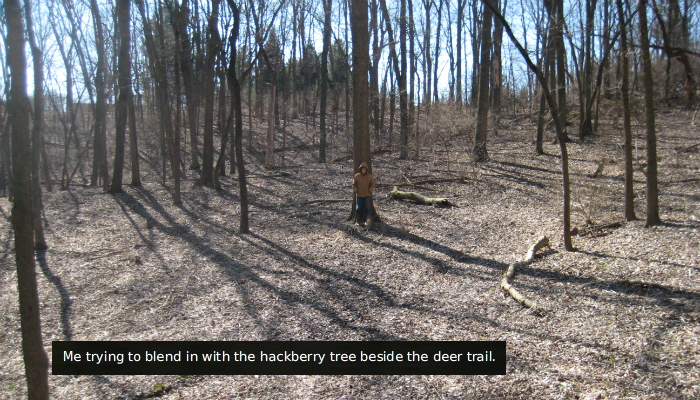A Deer Moment

One strangely warm February evening I leaned back against a hackberry tree alongside a deer trail, and just decided to close my eyes and listen. Soon, footsteps, a lot of footsteps, were heard lightly swishing through the dry leaves, and getting closer. Just as I slowly opened my eyes to narrow slits, a deer came around the tree to my right. Suddenly downwind of me and only a yard away, she jumped sideways from the odor, but still didn’t see me. And she jumped many more times, apparently unable to locate the problem.
In the meantime, four more deer came past on my left, also within touching distance, but upwind, so I could smell them. They paraded on past, focused on the first deer leaping around in a panic, and looked right past me, also without realizing that I wasn’t part of the tree trunk. They continued along the trail, still glancing back at the first deer, and finally stopped to stand and gawk from perhaps a hundred feet away. The first deer by then had calmed down a bit and nervously trotted off to join them. They never did see me, and drifted over the little hillcrest, out of sight.
This is not the first time I’ve become invisible, and my experience is that the alerted one doesn’t just flash its white tail and run, if it cannot discern a sense of direction telling it which way to run. This is logical, because accidently running toward a predator would turn a problem into a disaster, a good recipe for Darwinism selection.
So this spring, when you visit one of our Bur Oak Land Trust properties to admire the wildflowers and wonder over the returning warblers, also make an effort to just blend into the landscape for a while and observe. I usually have some observation goal or search image in mind, maybe to study tree growth patterns, or perhaps watch the evolution of some strange cloud. But then a chipmunk will come along and park himself on the toe of my boot to scold his neighbors, and my game plan changes as the little soap opera before me unfolds.
You don’t need camo clothing to become invisible, because many critters are colorblind (witness the success of hunters wearing blaze orange). But do avoid flashy bling. It is important to break up your outline by leaning snug against a tree or standing still in a clump of bushes or tall cattails. A cap with a long brim will put your eyes and glasses in shadow. Staring or eye motion is a red flag, so when a critter appears, I close my eyes down to slits. A surprising number of critters can be already nearby when you arrive, so arriving quietly will increase the odds they’ll come your way. Once you are in your spot, move as little as possible and then only in very slow motion. And even if no animal appears, taking the time to quietly commune with nature allows you to discover the displayed history of trees and bushes – you can start sorting out how the ecosystem you are standing in has evolved, where its trajectory might be taking it, and what its management options might be. For example, see my blog on box elder in the same woodlot: What Good is Boxelder?


